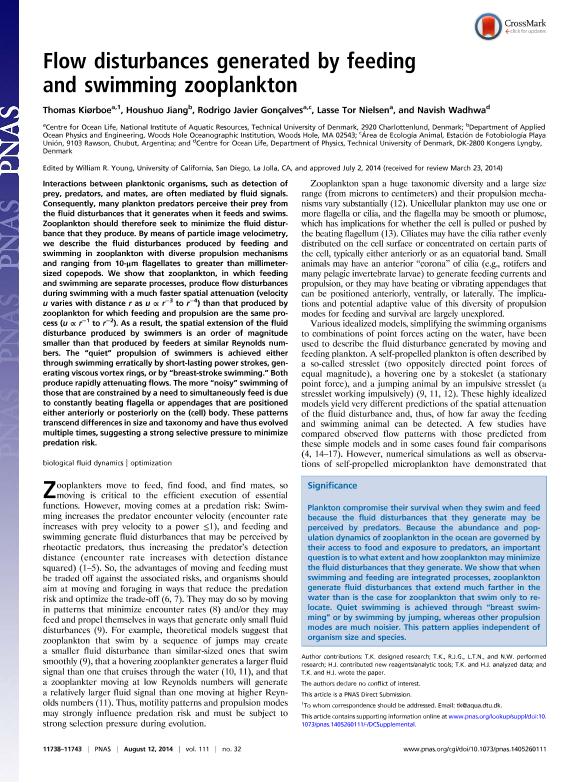Mostrar el registro sencillo del ítem
dc.contributor.author
Kiørboe, Thomas
dc.contributor.author
Jiang, Houshuo
dc.contributor.author
Gonçalves, Rodrigo Javier

dc.contributor.author
Nielsen, Lasse Tor
dc.contributor.author
Wadhwa, Navish
dc.date.available
2017-06-26T16:23:59Z
dc.date.issued
2014-08-12
dc.identifier.citation
Kiørboe, Thomas; Jiang, Houshuo; Gonçalves, Rodrigo Javier; Nielsen, Lasse Tor; Wadhwa, Navish; Flow disturbances generated by feeding and swimming zooplankton; National Academy Of Sciences; Proceedings of the National Academy of Sciences of The United States of America; 111; 32; 12-8-2014; 11738-11743
dc.identifier.issn
0027-8424
dc.identifier.uri
http://hdl.handle.net/11336/18869
dc.description.abstract
Interactions between planktonic organisms, such as detection of prey, predators, and mates, are often mediated by fluid signals. Consequently, many plankton predators perceive their prey from the fluid disturbances that it generates when it feeds and swims. Zooplankton should therefore seek to minimize the fluid disturbance that they produce. By means of particle image velocimetry, we describe the fluid disturbances produced by feeding and swimming in zooplankton with diverse propulsion mechanisms and ranging from 10-µm flagellates to greater than millimeter-sized copepods. We show that zooplankton, in which feeding and swimming are separate processes, produce flow disturbances during swimming with a much faster spatial attenuation (velocity u varies with distance r as u ∝ r−3 to r−4) than that produced by zooplankton for which feeding and propulsion are the same process (u ∝ r−1 to r−2). As a result, the spatial extension of the fluid disturbance produced by swimmers is an order of magnitude smaller than that produced by feeders at similar Reynolds numbers. The “quiet” propulsion of swimmers is achieved either through swimming erratically by short-lasting power strokes, generating viscous vortex rings, or by “breast-stroke swimming.” Both produce rapidly attenuating flows. The more “noisy” swimming of those that are constrained by a need to simultaneously feed is due to constantly beating flagella or appendages that are positioned either anteriorly or posteriorly on the (cell) body. These patterns transcend differences in size and taxonomy and have thus evolved multiple times, suggesting a strong selective pressure to minimize predation risk.
dc.format
application/pdf
dc.language.iso
eng
dc.publisher
National Academy Of Sciences

dc.rights
info:eu-repo/semantics/openAccess
dc.rights.uri
https://creativecommons.org/licenses/by-nc-sa/2.5/ar/
dc.subject
Zooplankton
dc.subject
Flow Disturbances
dc.subject
Swimming Behavior
dc.subject
Predator Avoidance
dc.subject.classification
Biología Marina, Limnología

dc.subject.classification
Ciencias Biológicas

dc.subject.classification
CIENCIAS NATURALES Y EXACTAS

dc.title
Flow disturbances generated by feeding and swimming zooplankton
dc.type
info:eu-repo/semantics/article
dc.type
info:ar-repo/semantics/artículo
dc.type
info:eu-repo/semantics/publishedVersion
dc.date.updated
2016-11-23T19:39:53Z
dc.journal.volume
111
dc.journal.number
32
dc.journal.pagination
11738-11743
dc.journal.pais
Estados Unidos

dc.journal.ciudad
Washington
dc.description.fil
Fil: Kiørboe, Thomas. Technical University of Denmark; Dinamarca
dc.description.fil
Fil: Jiang, Houshuo. Woods Hole Oceanographic Institution; Estados Unidos
dc.description.fil
Fil: Gonçalves, Rodrigo Javier. Fundación Playa Unión. Estación de Fotobiología Playa Unión; Argentina. Technical University of Denmark; Dinamarca. Consejo Nacional de Investigaciones Científicas y Técnicas; Argentina
dc.description.fil
Fil: Nielsen, Lasse Tor. Technical University of Denmark; Dinamarca
dc.description.fil
Fil: Wadhwa, Navish. Technical University of Denmark; Dinamarca
dc.journal.title
Proceedings of the National Academy of Sciences of The United States of America

dc.relation.alternativeid
info:eu-repo/semantics/altIdentifier/url/http://www.pnas.org/content/111/32/11738
dc.relation.alternativeid
info:eu-repo/semantics/altIdentifier/doi/http://dx.doi.org/10.1073/pnas.1405260111
Archivos asociados
